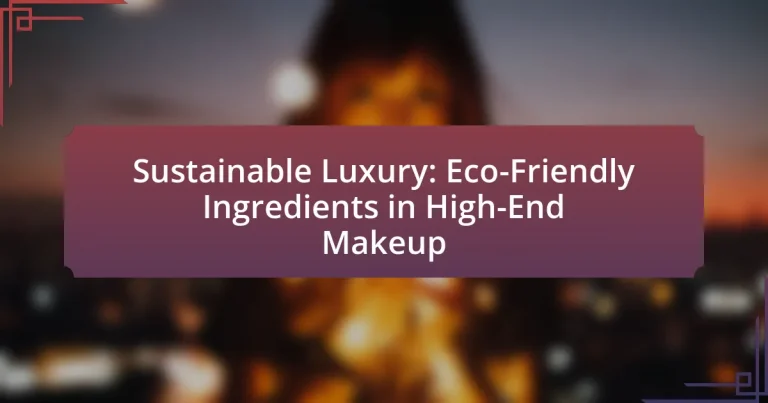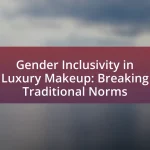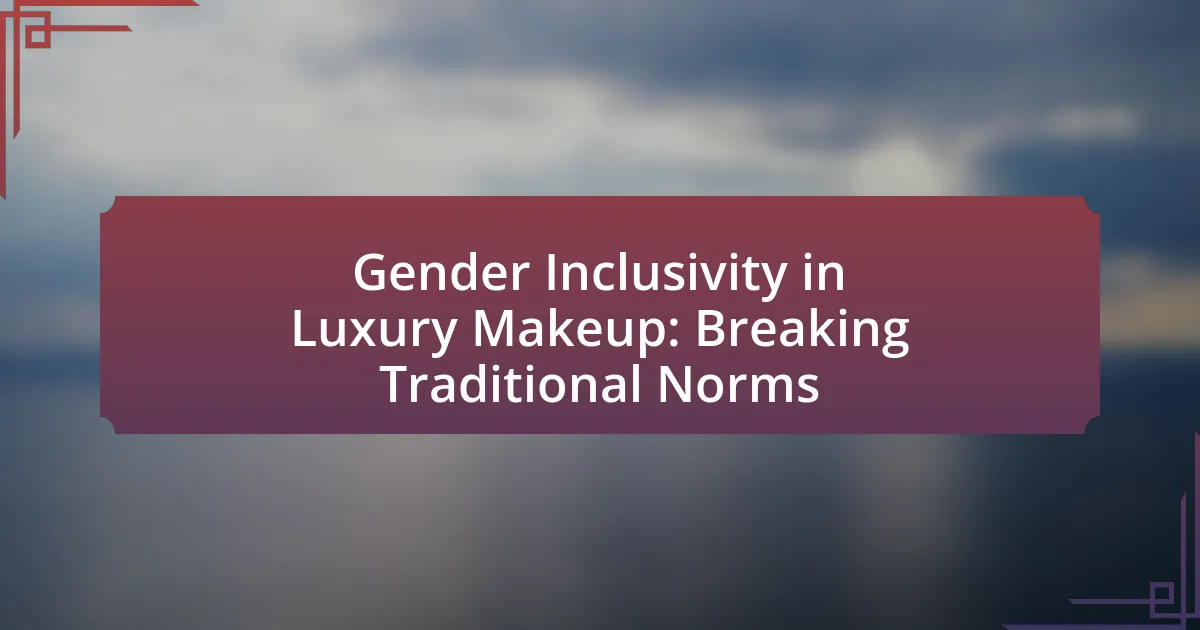Sustainable luxury in high-end makeup integrates eco-friendly practices and materials into the production and consumption of luxury cosmetics, emphasizing ethical sourcing, sustainable packaging, and responsible manufacturing. This article explores the differences between sustainable and traditional luxury, highlighting key principles such as environmental stewardship and social responsibility. It discusses the importance of eco-friendly ingredients, the challenges brands face in sourcing these materials, and the growing consumer demand for sustainable products. Additionally, it examines how brands communicate their commitment to sustainability and the future prospects for eco-friendly makeup in the beauty industry.
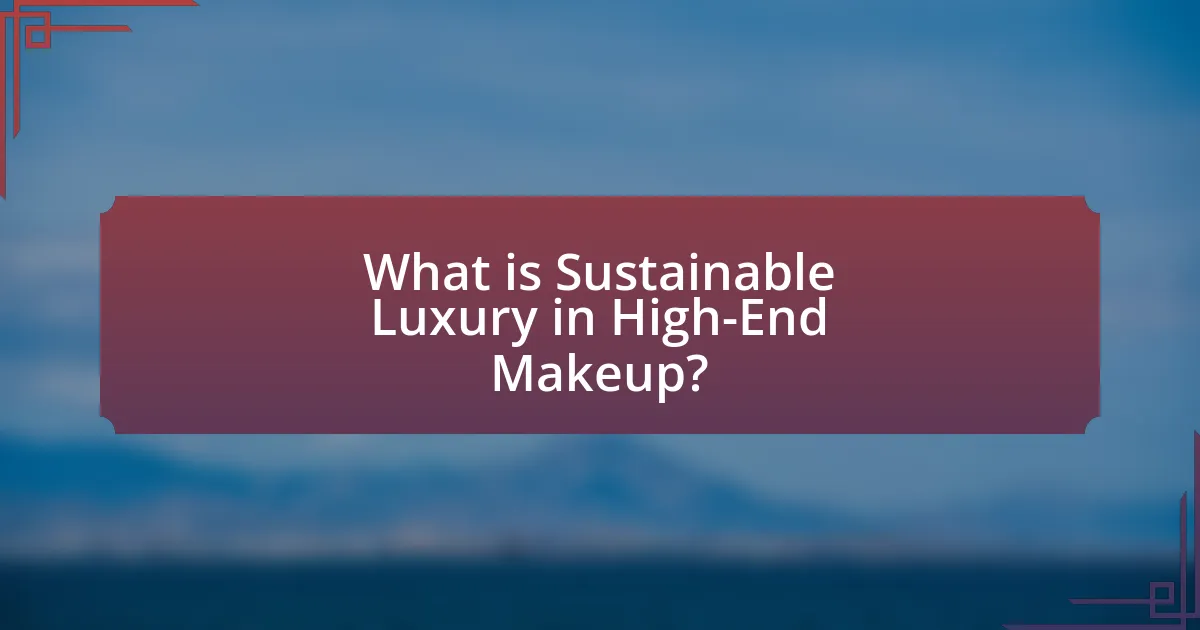
What is Sustainable Luxury in High-End Makeup?
Sustainable luxury in high-end makeup refers to the integration of eco-friendly practices and materials into the production and consumption of luxury cosmetics. This concept emphasizes the use of ethically sourced ingredients, sustainable packaging, and environmentally responsible manufacturing processes. For instance, brands like Gucci Beauty and Dior have adopted sustainable practices by utilizing biodegradable packaging and natural ingredients, which not only reduce environmental impact but also cater to the growing consumer demand for responsible luxury.
How does Sustainable Luxury differ from traditional luxury?
Sustainable luxury differs from traditional luxury primarily in its commitment to environmental and social responsibility. While traditional luxury often prioritizes exclusivity and opulence, sustainable luxury emphasizes ethical sourcing, eco-friendly materials, and fair labor practices. For instance, brands in the sustainable luxury sector may use organic ingredients and sustainable packaging, aligning with consumer demand for products that minimize environmental impact. This shift is supported by a growing market trend; a 2021 report by McKinsey indicated that 67% of consumers consider sustainability when making luxury purchases, highlighting the increasing importance of eco-consciousness in the luxury market.
What are the key principles of Sustainable Luxury?
The key principles of Sustainable Luxury include ethical sourcing, environmental stewardship, and social responsibility. Ethical sourcing ensures that materials are obtained from suppliers who adhere to fair labor practices and sustainable methods, minimizing harm to communities and ecosystems. Environmental stewardship focuses on reducing the ecological footprint through sustainable production processes, using eco-friendly materials, and promoting recycling and waste reduction. Social responsibility emphasizes the importance of giving back to communities and supporting initiatives that enhance social equity. These principles are increasingly adopted by luxury brands to align with consumer demand for sustainability, as evidenced by a 2021 McKinsey report indicating that 67% of consumers consider sustainability when making luxury purchases.
Why is Sustainable Luxury important in the beauty industry?
Sustainable luxury is important in the beauty industry because it addresses environmental concerns while meeting consumer demand for high-quality products. The beauty sector significantly contributes to pollution and waste, with the global cosmetics market projected to reach $805 billion by 2023, highlighting the need for eco-friendly practices. Brands that adopt sustainable luxury principles, such as using biodegradable packaging and ethically sourced ingredients, not only reduce their ecological footprint but also attract a growing demographic of environmentally conscious consumers. Research indicates that 66% of global consumers are willing to pay more for sustainable brands, demonstrating the market’s shift towards sustainability as a key factor in purchasing decisions.
What role do eco-friendly ingredients play in Sustainable Luxury?
Eco-friendly ingredients are essential in Sustainable Luxury as they align high-end makeup products with environmental responsibility and consumer demand for sustainability. These ingredients reduce the ecological footprint of luxury cosmetics by utilizing renewable resources, minimizing harmful chemicals, and promoting biodiversity. For instance, brands like Tata Harper and RMS Beauty emphasize natural and organic components, which not only enhance product quality but also appeal to environmentally conscious consumers. The shift towards eco-friendly formulations is supported by a growing market trend; a 2021 report by Grand View Research indicated that the global organic cosmetics market is expected to reach $25.11 billion by 2025, reflecting the increasing consumer preference for sustainable options.
Which eco-friendly ingredients are commonly used in high-end makeup?
High-end makeup commonly uses eco-friendly ingredients such as jojoba oil, shea butter, and natural pigments. Jojoba oil is favored for its moisturizing properties and skin compatibility, while shea butter provides nourishment and hydration. Natural pigments derived from minerals or plant sources are used to achieve vibrant colors without synthetic additives. These ingredients not only enhance product performance but also align with sustainable practices, as they are often sourced from renewable resources and have a lower environmental impact compared to conventional ingredients.
How do these ingredients impact product performance?
Eco-friendly ingredients significantly enhance product performance in high-end makeup by providing effective, skin-friendly benefits while minimizing environmental impact. For instance, natural oils like jojoba and argan oil offer superior hydration and nourishment compared to synthetic alternatives, leading to improved skin texture and appearance. Additionally, plant-based pigments deliver vibrant colors without harmful chemicals, ensuring both aesthetic appeal and safety for sensitive skin. Research indicates that products formulated with sustainable ingredients often exhibit better skin compatibility and lower irritation rates, as evidenced by a study published in the Journal of Cosmetic Science, which found that natural formulations resulted in higher user satisfaction and fewer adverse reactions.
What are the challenges of implementing eco-friendly ingredients in luxury makeup?
The challenges of implementing eco-friendly ingredients in luxury makeup include sourcing sustainable materials, maintaining product performance, and meeting consumer expectations. Sourcing sustainable materials can be difficult due to limited availability and higher costs associated with eco-friendly ingredients compared to conventional ones. Maintaining product performance is crucial, as luxury consumers expect high-quality results; eco-friendly formulations may not always match the efficacy of traditional ingredients. Additionally, meeting consumer expectations poses a challenge, as luxury brands must balance sustainability with the aesthetic and sensory experiences that high-end customers demand. These factors collectively complicate the integration of eco-friendly practices in the luxury makeup sector.
How do brands overcome sourcing challenges for sustainable ingredients?
Brands overcome sourcing challenges for sustainable ingredients by establishing direct relationships with suppliers and investing in sustainable farming practices. By collaborating closely with farmers, brands can ensure a consistent supply of high-quality, eco-friendly ingredients while also supporting local economies. For instance, companies like L’Oréal have implemented programs to source raw materials sustainably, which includes training farmers in sustainable agriculture techniques. This approach not only secures the supply chain but also enhances the quality of the ingredients used in high-end makeup products.
What are the cost implications of using eco-friendly ingredients?
Using eco-friendly ingredients typically results in higher costs for manufacturers due to factors such as sourcing, production, and certification processes. These ingredients often come from sustainable farms that may have lower yields and higher labor costs, leading to increased prices compared to conventional ingredients. For instance, a study by the Organic Trade Association found that organic ingredients can be 20-50% more expensive than their non-organic counterparts. Additionally, eco-friendly certifications, such as Fair Trade or USDA Organic, involve fees that further elevate costs. Consequently, these financial implications can lead to higher retail prices for consumers in the high-end makeup market.
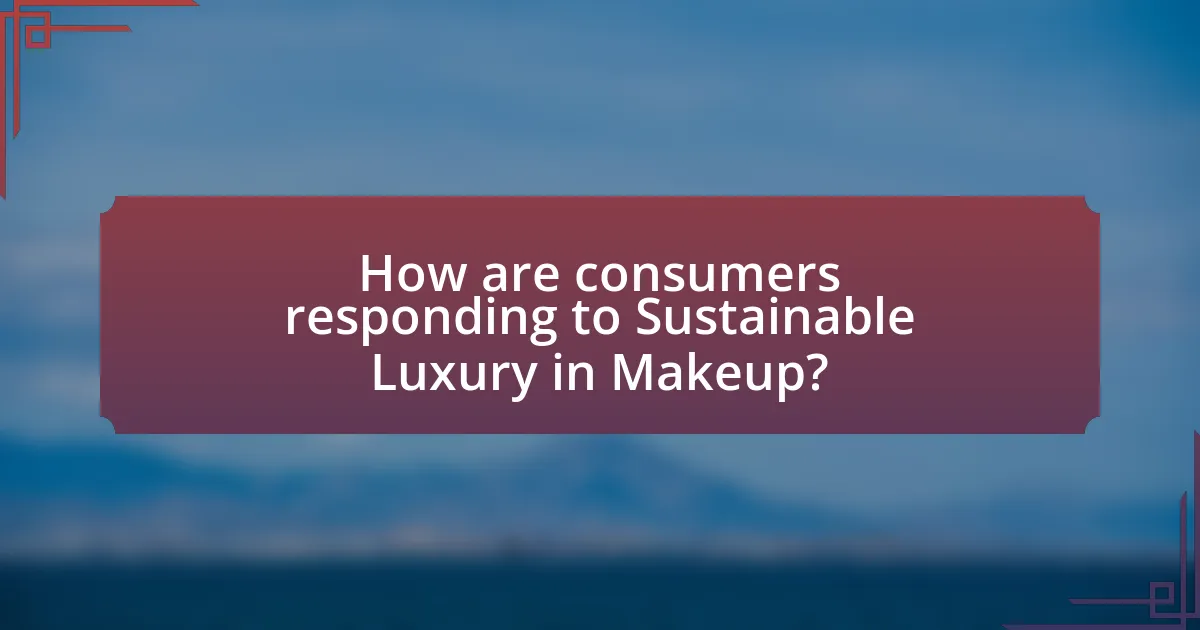
How are consumers responding to Sustainable Luxury in Makeup?
Consumers are increasingly favoring sustainable luxury in makeup, demonstrating a strong preference for brands that prioritize eco-friendly ingredients and ethical practices. A survey by McKinsey & Company found that 67% of consumers consider sustainability an important factor in their purchasing decisions, particularly among younger demographics. This shift is reflected in the growing market for sustainable beauty products, which is projected to reach $13.2 billion by 2025, indicating a robust demand for luxury makeup that aligns with environmental values.
What trends are emerging in consumer preferences for eco-friendly makeup?
Emerging trends in consumer preferences for eco-friendly makeup include a significant shift towards clean ingredients, sustainable packaging, and transparency in sourcing. Consumers increasingly prioritize products that are free from harmful chemicals, with a 2022 survey indicating that 70% of consumers are willing to pay more for makeup that is environmentally friendly. Additionally, there is a growing demand for brands that utilize biodegradable or recyclable packaging, reflecting a broader commitment to sustainability. Transparency regarding ingredient sourcing is also becoming crucial, as consumers seek brands that provide clear information about their environmental impact and ethical practices.
How does consumer awareness influence purchasing decisions?
Consumer awareness significantly influences purchasing decisions by driving demand for products that align with ethical and sustainable practices. As consumers become more informed about the environmental and social impacts of their purchases, they increasingly prefer brands that utilize eco-friendly ingredients and sustainable sourcing methods. For instance, a survey by Nielsen found that 73% of millennials are willing to pay more for sustainable products, indicating a strong correlation between consumer awareness and purchasing behavior. This shift in consumer preferences compels high-end makeup brands to adopt sustainable practices to maintain market competitiveness and meet the expectations of their informed customer base.
What demographic factors affect the demand for Sustainable Luxury products?
The demand for Sustainable Luxury products is significantly influenced by demographic factors such as age, income level, education, and geographic location. Younger consumers, particularly Millennials and Generation Z, show a higher preference for sustainable products, with 73% of Millennials willing to pay more for sustainable offerings, according to a 2019 Nielsen report. Higher income levels correlate with increased demand for luxury items, including sustainable options, as affluent consumers often prioritize ethical consumption. Education also plays a crucial role; individuals with higher education levels tend to be more aware of environmental issues and thus more inclined to purchase sustainable luxury products. Additionally, geographic location affects demand, with urban areas typically exhibiting a stronger preference for sustainable luxury due to greater access to information and eco-conscious brands.
How do brands communicate their commitment to sustainability?
Brands communicate their commitment to sustainability through transparent messaging, eco-friendly product formulations, and sustainable practices. For instance, high-end makeup brands often highlight the use of eco-friendly ingredients, such as plant-based oils and natural pigments, in their marketing materials. Additionally, they may provide detailed information about their sourcing practices, such as using responsibly harvested materials or supporting fair trade initiatives. Brands also engage in sustainability certifications, like the Leaping Bunny or EcoCert, which validate their claims and enhance consumer trust. Furthermore, many brands actively share their sustainability goals and progress through social media campaigns and annual sustainability reports, demonstrating accountability and fostering a connection with environmentally conscious consumers.
What marketing strategies are effective for promoting eco-friendly makeup?
Effective marketing strategies for promoting eco-friendly makeup include leveraging social media influencers, emphasizing transparency in ingredient sourcing, and highlighting sustainability certifications. Social media influencers can reach targeted audiences, as studies show that 49% of consumers depend on influencer recommendations for product purchases. Transparency in ingredient sourcing builds trust, with 73% of consumers willing to pay more for products from brands that provide complete information about their ingredients. Additionally, showcasing sustainability certifications, such as cruelty-free or organic labels, can enhance brand credibility and appeal, as 66% of consumers consider sustainability when making purchasing decisions.
How important is transparency in ingredient sourcing for consumers?
Transparency in ingredient sourcing is crucial for consumers, particularly in the context of sustainable luxury and eco-friendly products. Consumers increasingly demand to know the origins and ethical implications of the ingredients used in high-end makeup, as evidenced by a 2021 survey from the International Cosmetic Ingredient Review, which found that 75% of consumers prioritize transparency when selecting beauty products. This demand for clarity not only fosters trust between brands and consumers but also encourages companies to adopt sustainable practices, thereby enhancing the overall integrity of the beauty industry.

What are the future prospects for Sustainable Luxury in the makeup industry?
The future prospects for Sustainable Luxury in the makeup industry are promising, driven by increasing consumer demand for eco-friendly products and ethical practices. Market research indicates that the global sustainable cosmetics market is projected to grow significantly, with a compound annual growth rate (CAGR) of over 9% from 2021 to 2028, reflecting a shift towards brands that prioritize sustainability. Major luxury brands are already investing in sustainable sourcing, biodegradable packaging, and clean formulations, aligning with consumer preferences for transparency and environmental responsibility. This trend is further supported by initiatives such as the Sustainable Cosmetics Summit, which emphasizes the importance of sustainability in luxury beauty.
How is innovation shaping the future of eco-friendly makeup products?
Innovation is significantly shaping the future of eco-friendly makeup products by introducing sustainable materials and advanced technologies that reduce environmental impact. For instance, brands are increasingly utilizing biodegradable packaging and plant-based ingredients, which minimize waste and reliance on synthetic chemicals. Research indicates that the global market for sustainable cosmetics is projected to reach $20.3 billion by 2025, reflecting a growing consumer demand for eco-conscious products. Additionally, innovations such as waterless formulations and refillable containers are becoming mainstream, further enhancing sustainability in the beauty industry. These advancements not only cater to environmentally aware consumers but also align with regulatory trends favoring greener practices, thereby driving the evolution of eco-friendly makeup products.
What role does technology play in developing sustainable ingredients?
Technology plays a crucial role in developing sustainable ingredients by enabling innovative methods for sourcing, processing, and formulating eco-friendly materials. Advanced techniques such as biotechnology and synthetic biology allow for the creation of sustainable alternatives to traditional ingredients, reducing reliance on natural resources. For instance, companies are using fermentation processes to produce bio-based ingredients, which can significantly lower carbon footprints and minimize environmental impact. Research indicates that biotechnological advancements can lead to a 30% reduction in resource use compared to conventional methods, demonstrating the effectiveness of technology in promoting sustainability in ingredient development.
How can brands balance luxury and sustainability moving forward?
Brands can balance luxury and sustainability by integrating eco-friendly materials and ethical practices into their production processes. This approach involves sourcing high-quality, sustainable ingredients that do not compromise the luxury experience, such as organic botanicals and biodegradable packaging. For instance, a study by McKinsey & Company highlights that 67% of consumers are willing to pay more for sustainable products, indicating a market demand for luxury brands to adopt sustainable practices without sacrificing quality. By prioritizing transparency and sustainability, brands can enhance their appeal to environmentally conscious consumers while maintaining their luxury status.
What practical tips can consumers follow when choosing eco-friendly makeup?
Consumers can follow several practical tips when choosing eco-friendly makeup. First, they should look for products with certified organic ingredients, as these are grown without synthetic pesticides and fertilizers, ensuring a lower environmental impact. Additionally, consumers should check for cruelty-free certifications, which indicate that the products were not tested on animals, aligning with ethical standards.
Moreover, selecting brands that use sustainable packaging, such as recyclable or biodegradable materials, helps reduce waste. Consumers can also research the brand’s overall sustainability practices, including their sourcing and manufacturing processes, to ensure they align with eco-friendly values. Lastly, opting for multi-use products can minimize consumption and waste, making makeup routines more sustainable.
How can consumers identify truly sustainable products?
Consumers can identify truly sustainable products by looking for certifications such as Fair Trade, USDA Organic, or the Global Organic Textile Standard (GOTS). These certifications indicate adherence to specific environmental and social standards. Additionally, consumers should examine ingredient lists for eco-friendly components, such as plant-based or biodegradable materials, and avoid products with harmful chemicals like parabens or sulfates. Research shows that brands committed to sustainability often disclose their sourcing practices and environmental impact, providing transparency that can be verified through third-party audits. For example, a study published in the Journal of Cleaner Production highlights that products with clear sustainability claims and certifications are more likely to meet consumer expectations for environmental responsibility.
What are the best practices for supporting sustainable beauty brands?
To support sustainable beauty brands, consumers should prioritize purchasing products that use eco-friendly ingredients and sustainable packaging. Research indicates that brands utilizing natural, biodegradable, and ethically sourced materials significantly reduce environmental impact. Additionally, consumers can support these brands by advocating for transparency in ingredient sourcing and production processes, as brands that disclose their practices often demonstrate a commitment to sustainability. Engaging with and promoting brands that participate in fair trade and cruelty-free certifications further reinforces the importance of ethical practices in the beauty industry.
